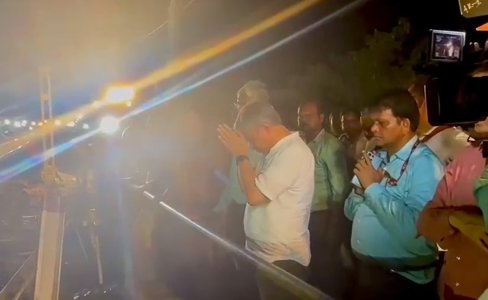- Joined
- Oct 2, 2004
- Runs
- 217,186
Many people are feared dead and hundreds of others have been injured after a train crash in eastern India.
At least 50 people have reportedly been killed after a passenger train derailed and collided with a goods train in Odisha's Balasore district.
Rescuers were attempting to free 200 people feared trapped in the derailed coaches, D B Shinde, the Balasore district administrator in Odisha state said.
The Coromandel Express, which runs from Kolkata to Chennai, derailed after the collision and fell on the opposite track, reports said.
India's prime minister Narendra Modi said he is "distressed" by the accident and said rescue operations are underway at the site.
Photos from the scene show people trying to escape from a toppled vehicle.
Pradeep Jena, Odisha's chief secretary, said: "Nearly 50 ambulances have reported but the injured appear far too many. Large (number) of buses being mobilised to shift injured to hospital."
A railroad ministry spokesperson, Amitabh Sharma, said mangled pieces of the derailed train fell on to a nearby track and were hit by another passenger train coming in the opposite direction.
More than 12 million people ride 14,000 trains across India every day, traveling on 40,000 miles of track.
SKY
At least 50 people have reportedly been killed after a passenger train derailed and collided with a goods train in Odisha's Balasore district.
Rescuers were attempting to free 200 people feared trapped in the derailed coaches, D B Shinde, the Balasore district administrator in Odisha state said.
The Coromandel Express, which runs from Kolkata to Chennai, derailed after the collision and fell on the opposite track, reports said.
India's prime minister Narendra Modi said he is "distressed" by the accident and said rescue operations are underway at the site.
Photos from the scene show people trying to escape from a toppled vehicle.
Pradeep Jena, Odisha's chief secretary, said: "Nearly 50 ambulances have reported but the injured appear far too many. Large (number) of buses being mobilised to shift injured to hospital."
A railroad ministry spokesperson, Amitabh Sharma, said mangled pieces of the derailed train fell on to a nearby track and were hit by another passenger train coming in the opposite direction.
More than 12 million people ride 14,000 trains across India every day, traveling on 40,000 miles of track.
SKY








